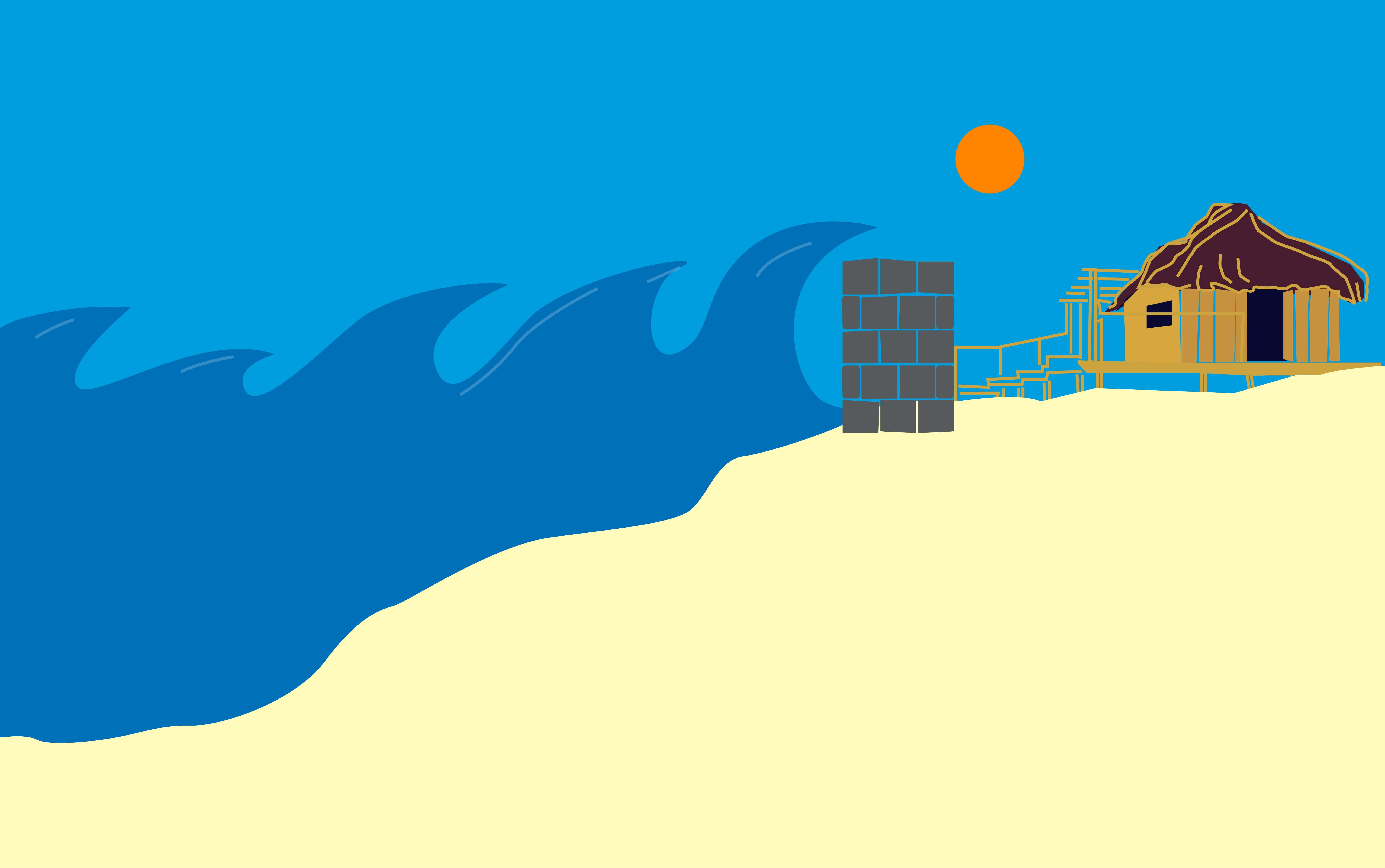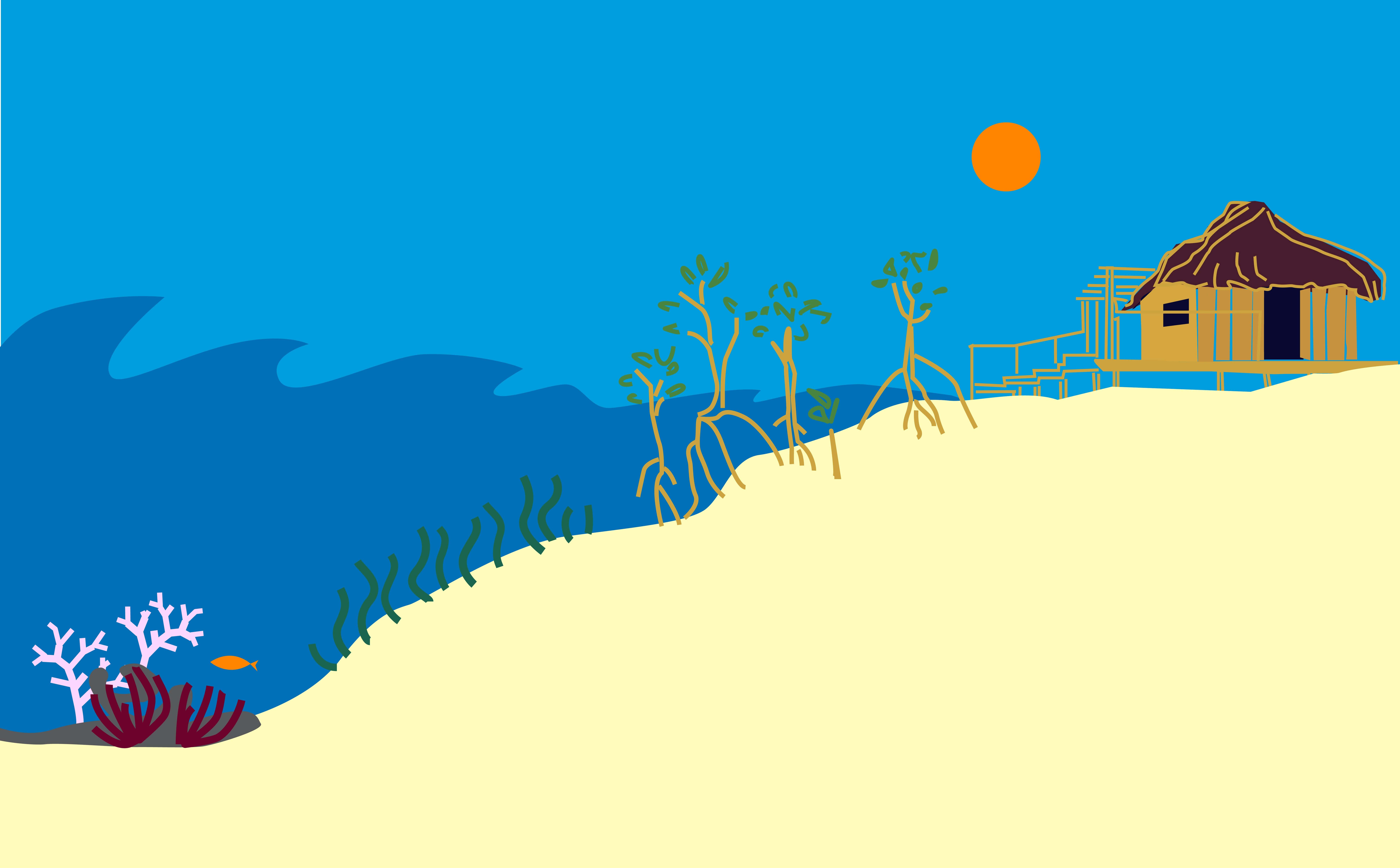Moving the needle - coastal risk to resilience

Bringing together local stakeholders, investment, and international cooperation creates opportunities to transform from risk to resilience.
In the Indian Ocean off the coast of Kenya, lies the small island of Wasini. The equatorial sun shines bright. The ocean is turquoise and inviting. Powdery soft sand covers the beaches. Dense, mangrove forests line some of the coast, while healthy coral reefs and fisheries can be found below the surface.
Going back a few years things were different. The mangrove forest and coral reefs were degraded and fishing dependent communities were struggling. But through a combination of community effort, targeted investment and international cooperation the island of Wasini has been able to shift from dealing with increasing risks to building resilience.
How did Wasini make this shift? With help from Seacology and its partners, the local communities in Wasini identified key intervention points to build resilience, attracted support and took action. They set up a 500-hectare protective area around the mangrove forest and created a marine protected area (MPA) to help the coral reefs and fish populations recover. They also constructed rainwater harvesting cisterns, as importing freshwater was costly and draining local incomes.

Coral reefs and mangroves provide multiple benefits for the local communities and the planet. They provide a livelihood source through ecotourism, fisheries and mangrove beekeeping. They protect communities from storm surges and are a valuable source of carbon sequestration.
Coastal areas around the world have been facing an onslaught of hazards and disasters including storm surges, flooding, sea level rise, biodiversity loss, bleached corals, and over-exploited fisheries. These shocks and stresses continue to be on the rise. In 2020, total damage from natural hazard-related disasters was US$210 billion. Built infrastructure like seawalls and breakwaters are put up to protect against some of these hazards, but they only combat one or two of the surface issues.
Building coastal resilience is about addressing the needs of local communities. But it also goes beyond addressing immediate local needs, to building a wider evidence base that demonstrates the business case for increasing investment and securing international cooperation to enhance protection of coastal ecosystems at scale. This systemic resilience-building approach is critical to move the needle from coastal risk to resilience.

Nature-based Solutions
Ecosystems like mangroves, coral reefs, wetlands, and swamps reduce the impacts of natural hazard-related disasters and climate events. It is estimated that mangroves provide flood protection benefits of over $65 billion per year. These ecosystems and the benefits they provide are often referred to as Nature-based Solutions.
Karen Sack, CEO and President of Ocean Unite and Co-Chair of the Ocean Risk & Resilience Action Alliance (ORRAA), says, “They [mangroves and reefs] are a first line of defence against storm surges and sea level rise, and are critical to sustaining local livelihoods, communities, and their economies.”
Building resilience and creating an insurance against future risks requires drawing on the resilience attributes of diversity and redundancy. Dense, healthy mangrove forests on their own can reduce storm surges by 66%. But if coral reefs are also present this decreases wave strength and height, which further lessens the effect of storm surges and flooding. Redundancy is about having multiple options in the face of shocks, like storm surges or disasters. Additionally, multiple ecosystems together promote biological diversity.


How coral reefs, seagrass beds, and mangroves can decrease wave strength and reduce flooding compared to a seawall. Illustration: E. Jonsson/Azote
Smart Investing
“Investing in coastal resilience is simply smart economics,” said Gonzalo Munoz, High Level Climate Champion of COP25, at a Latin America and Caribbean Climate Week event. Yet, investment often faces barriers.
“Mangroves have reduced the cost of property loss by over $80 billion a year globally,” notes Moushumi Chaudhury, Community Resilience Program Director at The Nature Conservancy (TNC). Investing in coastal ecosystems is often much cheaper compared to other types of built solutions. A recent study from the Caribbean shows that Nature-based Solutions are 10 – 100 times cheaper compared to artificial defenses and can help avert up to 45% of climate risk in coastal zones.

Involve Local Communities and Local Government
In order to reap the rewards of investing in coastal ecosystems and Nature-based Solutions, local communities need to be included in projects from the outset. Currently, 700 million people live in coastal areas prone to oceanic risks; this could increase to one billion by 2050. Empowering local stakeholders to lead in resilience building gives communities on the frontline a voice in decisions that directly affect their lives and livelihoods. As highlighted in the Locally Led Adaptation principles, not involving local communities leads to less effective interventions that are more likely to produce negative outcomes.
TNC’s Chaudhury agrees, “Local communities are the guardians of these natural infrastructure, such as mangroves and coral reefs; without their support for these projects they will not succeed.”
Karen Peterson, Senior Manager at Seacology, says, “Seacology works specifically with natural ecosystems and collaborates directly with local communities on initiatives. We partner with communities from the inception. We are careful to never assume what a community needs.”
Locally Led Adaptation is about recognising local people and community agency over interventions and working with higher levels of governance to implement and deliver solutions.
Dishon Murage, a participatory resource practitioner based out of Kenya highlights that “One key challenge we face, is that conservation and environmental matters don’t take priority over economic development.”
For example further up the Kenyan coast lies Lamu Island. As in Wasini, the local community established a protective area around the coral reef and brought tourists to the area for snorkelling and diving. The community had been protecting the ecosystems for more than 60 years. “This worked very well for a time until the government decided to develop the second biggest port in Kenya in this area,” says Murage. The area was dredged and essentially all the corals were destroyed with many ripple effects that have eroded resilience across a large area.
Highlighting different, innovative development pathways is important. Murage spoke about successful initiatives involving local decision-making and Nature-based Solutions. He says, ”Governments have their own budgeting processes, and Nature-based Solutions initiatives have been successful when they are included in the government’s budgeting framework.” This provides sustainability to the project beyond donor funding and amplifies the importance of local communities working together with higher levels of governance to implement and deliver resilient solutions.
International Cooperation
Beyond domestic and local contexts to drive action in enhancing coastal resilience, international cooperation is also essential. The Sendai Framework for Disaster Risk Reduction outlines seven targets and four priority action areas to prevent new and reduce existing disaster risks. Target F specifically focuses on enhancing international cooperation to developing countries.
Currently, 101 countries have developed Disaster Risk Reduction strategies, but only 40% of Least Developed Countries (LDCs) and Small Island Developing States (SIDS) have access to multi-hazard early warning systems. Hence, international cooperation is needed to strengthen multi-hazard early warning systems to promote resilience.
Nature-based Solutions should also be included in disaster risk reduction planning. The Nature Conservancy recently launched The Blue Guide to Coastal Resilience. This is a hands-on, practical guide for disaster risk reduction practitioners and planners. TNC’s Chaudhury says, “It provides DRR practitioners with step-by-step guidance for integrating various Nature-based Solutions into Disaster Risk Reduction Planning.” The guide is specific for coastal areas to support those who are climate-vulnerable and to help them adapt to climate change. The guide not only emphasizes Nature-based Solutions, but also aims to help DRR planners shift from short-term planning to long-term planning that supports livelihoods. Another useful guide is the Words Into Action Nature-based Solution guide.

The Ocean Risk & Resilience Action Alliance (ORRAA) is working to enhance international cooperation in coastal regions. ORRAA is a multi-stakeholder alliance that brings together insurance and finance sectors, governments, multilateral banks, NGOs, intergovernmental organizations and universities. ORRAA works to pioneer finance and insurance products that incentivise investments into Nature-based Solutions, with a focus on protecting regions and coastal communities.
One of the ORRAA projects, Understanding Ocean-Derived Risks Facing Coastal Communities in SIDS and LDCs, is synthesizing the latest knowledge and generating new insights on key emerging ocean risks and their implications for resilience and human wellbeing in SIDS and LDCs. This research is led by the Stockholm Resilience Centre (SRC) and Stanford Center for Ocean Solutions, and will contribute to the UN Decade of Ocean Science for Sustainable Development.
Transforming Risks to Opportunities
To move from coastal risk to resilience, we need to work together to engage and support local communities, increase investment and finance opportunities, and strengthen international cooperation and understanding. Prioritizing investment to protect and build coastal ecosystems is vital, so Wasini and other coastal areas with thriving ecosystems and communities become the norm rather than the exception.
This piece is part of the From Risk to Resilience series, a content partnership between the UN Office for Disaster Risk Reduction (UNDRR) and the Global Resilience Partnership (GRP).
Ida Gabrielsson is a Partnership and Engagement Officer for the Global Resilience Partnership (GRP). Before joining the GRP Secretariat, Gabrielsson worked as a Communications and Impact Officer for the ESPA-funded project, Sustainable Poverty Alleviation from Coastal Ecosystem Services (SPACES). Gabrielsson holds a MSc in Environmental Science with a focus on environmental communication from the Swedish University of Agricultural Sciences (SLU).